Higgins R.A. Engineering Metallurgy: Applied Physical Metallurgy
Подождите немного. Документ загружается.

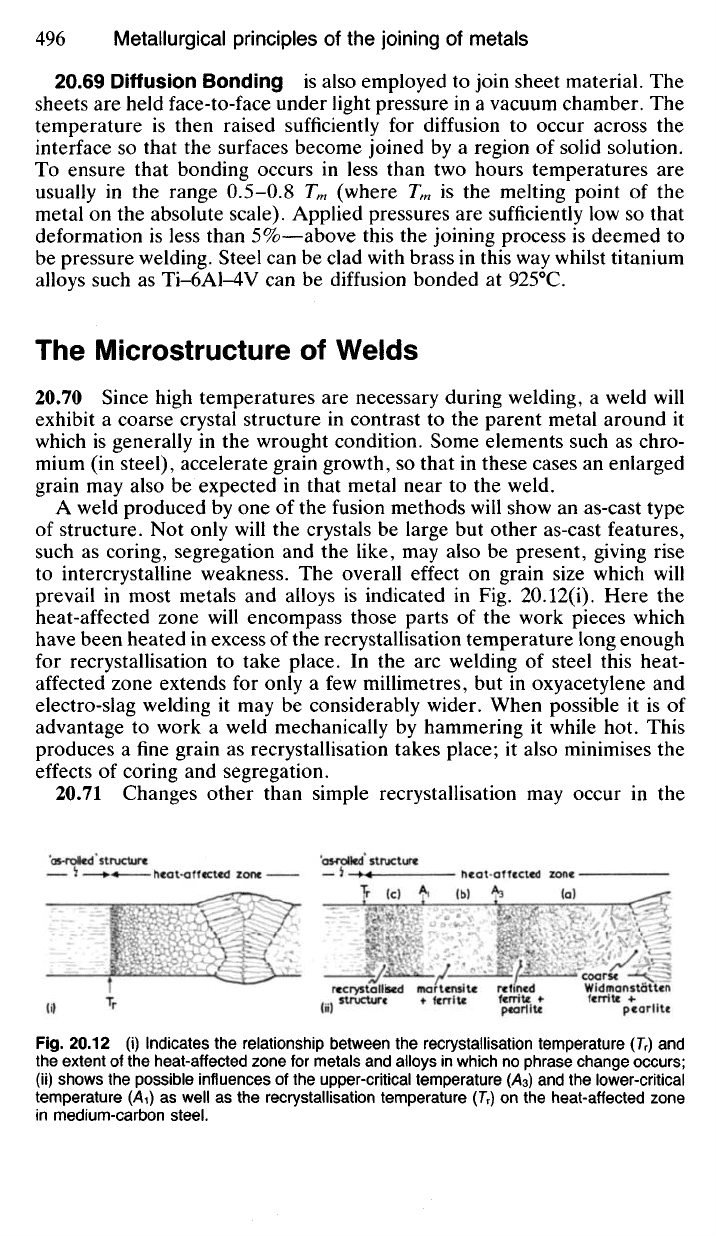
20.69 Diffusion Bonding is also employed to join sheet material. The
sheets are held face-to-face under light pressure in a vacuum chamber. The
temperature is then raised sufficiently for diffusion to occur across the
interface so that the surfaces become joined by a region of solid solution.
To ensure that bonding occurs in less than two hours temperatures are
usually in the range 0.5-0.8 T
m
(where T
m
is the melting point of the
metal on the absolute scale). Applied pressures are sufficiently low so that
deformation is less than 5%—above this the joining process is deemed to
be pressure welding. Steel can be clad with brass in this way whilst titanium
alloys such as Ti-6A1-4V can be diffusion bonded at 925°C.
The Microstructure of Welds
20.70 Since high temperatures are necessary during welding, a weld will
exhibit a coarse crystal structure in contrast to the parent metal around it
which is generally in the wrought condition. Some elements such as chro-
mium (in steel), accelerate grain growth, so that in these cases an enlarged
grain may also be expected in that metal near to the weld.
A weld produced by one of the fusion methods will show an as-cast type
of structure. Not only will the crystals be large but other as-cast features,
such as coring, segregation and the like, may also be present, giving rise
to intercrystalline weakness. The overall effect on grain size which will
prevail in most metals and alloys is indicated in Fig. 20.12(i). Here the
heat-affected zone will encompass those parts of the work pieces which
have been heated in excess of the recrystallisation temperature long enough
for recrystallisation to take place. In the arc welding of steel this heat-
affected zone extends for only a few millimetres, but in oxyacetylene and
electro-slag welding it may be considerably wider. When possible it is of
advantage to work a weld mechanically by hammering it while hot. This
produces a fine grain as recrystallisation takes place; it also minimises the
effects of coring and segregation.
20.71 Changes other than simple recrystallisation may occur in the
Fig.
20.12 (i) Indicates the relationship between the recrystallisation temperature (T
r
) and
the extent of the heat-affected zone for metals and alloys in which no phrase change occurs;
(ii) shows the possible influences of the upper-critical temperature [A
3
) and the lower-critical
temperature (/\i) as well as the recrystallisation temperature (7"
r
) on the heat-affected zone
in medium-carbon steel.
'as-rolled structure
heat-affected zone
'as-rolled structure
heat-affected zone
rccrystalliscd
structure
mar tensitc
+ ferrite
refined
ferrite •
pearl
i
U
coarse
Widmanstatten
ferrite +
pearlite
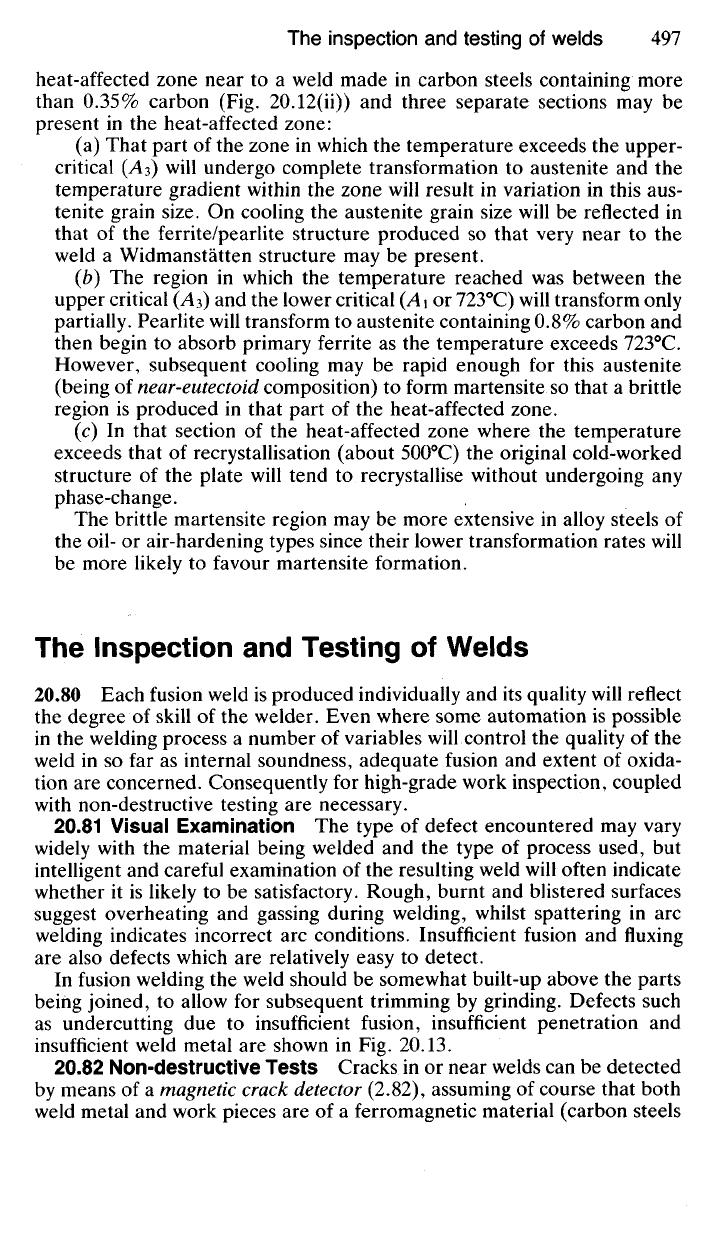
heat-affected zone near to a weld made in carbon steels containing more
than 0.35% carbon (Fig. 20.12(ii)) and three separate sections may be
present in the heat-affected zone:
(a) That part of the zone in which the temperature exceeds the upper-
critical (A
3
) will undergo complete transformation to austenite and the
temperature gradient within the zone will result in variation in this aus-
tenite grain size. On cooling the austenite grain size will be reflected in
that of the ferrite/pearlite structure produced so that very near to the
weld a Widmanstatten structure may be present.
(b) The region in which the temperature reached was between the
upper critical (/I
3
) and the lower critical (A\ or 723°C) will transform only
partially. Pearlite will transform to austenite containing 0.8% carbon and
then begin to absorb primary ferrite as the temperature exceeds 723°C.
However, subsequent cooling may be rapid enough for this austenite
(being of
near-eutectoid
composition) to form martensite so that a brittle
region is produced in that part of the heat-affected zone.
(c) In that section of the heat-affected zone where the temperature
exceeds that of recrystallisation (about 500
0
C) the original cold-worked
structure of the plate will tend to recrystallise without undergoing any
phase-change.
The brittle martensite region may be more extensive in alloy steels of
the oil- or air-hardening types since their lower transformation rates will
be more likely to favour martensite formation.
The Inspection and Testing of Welds
20.80 Each fusion weld is produced individually and its quality will reflect
the degree of skill of the welder. Even where some automation is possible
in the welding process a number of variables will control the quality of the
weld in so far as internal soundness, adequate fusion and extent of oxida-
tion are concerned. Consequently for high-grade work inspection, coupled
with non-destructive testing are necessary.
20.81 Visual Examination The type of defect encountered may vary
widely with the material being welded and the type of process used, but
intelligent and careful examination of the resulting weld will often indicate
whether it is likely to be satisfactory. Rough, burnt and blistered surfaces
suggest overheating and gassing during welding, whilst spattering in arc
welding indicates incorrect arc conditions. Insufficient fusion and fluxing
are also defects which are relatively easy to detect.
In fusion welding the weld should be somewhat built-up above the parts
being joined, to allow for subsequent trimming by grinding. Defects such
as undercutting due to insufficient fusion, insufficient penetration and
insufficient weld metal are shown in Fig.
20.13.
20.82 Non-destructive Tests Cracks in or near welds can be detected
by means of a magnetic crack detector (2.82), assuming of course that both
weld metal and work pieces are of a ferromagnetic material (carbon steels
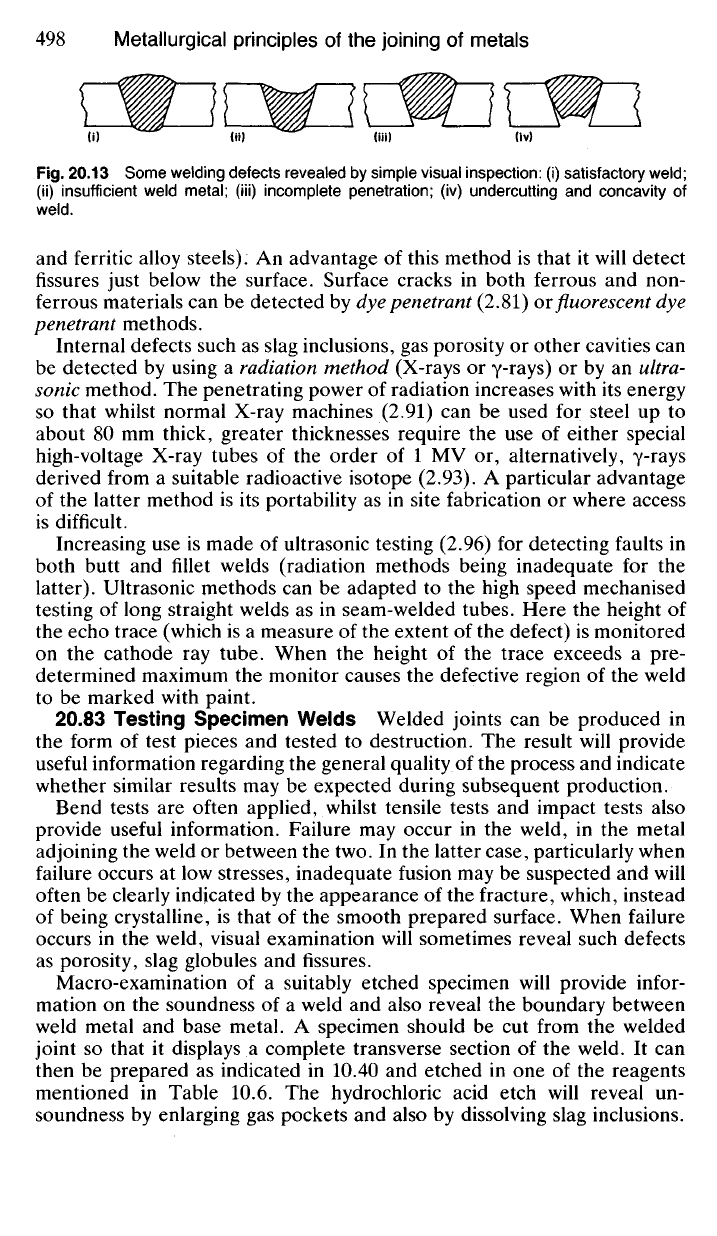
Fig.
20.13 Some welding defects revealed by simple visual inspection: (i) satisfactory weld;
(ii) insufficient weld metal; (iii) incomplete penetration; (iv) undercutting and concavity of
weld.
and ferritic alloy steels). An advantage of this method is that it will detect
fissures just below the surface. Surface cracks in both ferrous and non-
ferrous materials can be detected by dye penetrant (2.81) ox fluorescent dye
penetrant methods.
Internal defects such as slag inclusions, gas porosity or other cavities can
be detected by using a radiation method (X-rays or y-rays) or by an ultra-
sonic method. The penetrating power of radiation increases with its energy
so that whilst normal X-ray machines (2.91) can be used for steel up to
about 80 mm thick, greater thicknesses require the use of either special
high-voltage X-ray tubes of the order of 1 MV or, alternatively, y-rays
derived from a suitable radioactive isotope (2.93). A particular advantage
of the latter method is its portability as in site fabrication or where access
is difficult.
Increasing use is made of ultrasonic testing (2.96) for detecting faults in
both butt and fillet welds (radiation methods being inadequate for the
latter).
Ultrasonic methods can be adapted to the high speed mechanised
testing of long straight welds as in seam-welded tubes. Here the height of
the echo trace (which is a measure of the extent of the defect) is monitored
on the cathode ray tube. When the height of the trace exceeds a pre-
determined maximum the monitor causes the defective region of the weld
to be marked with paint.
20.83 Testing Specimen Welds Welded joints can be produced in
the form of test pieces and tested to destruction. The result will provide
useful information regarding the general quality of the process and indicate
whether similar results may be expected during subsequent production.
Bend tests are often applied, whilst tensile tests and impact tests also
provide useful information. Failure may occur in the weld, in the metal
adjoining the weld or between the two. In the latter case, particularly when
failure occurs at low stresses, inadequate fusion may be suspected and will
often be clearly indicated by the appearance of the fracture, which, instead
of being crystalline, is that of the smooth prepared surface. When failure
occurs in the weld, visual examination will sometimes reveal such defects
as porosity, slag globules and fissures.
Macro-examination of a suitably etched specimen will provide infor-
mation on the soundness of a weld and also reveal the boundary between
weld metal and base metal. A specimen should be cut from the welded
joint so that it displays a complete transverse section of the weld. It can
then be prepared as indicated in 10.40 and etched in one of the reagents
mentioned in Table 10.6. The hydrochloric acid etch will reveal un-
soundness by enlarging gas pockets and also by dissolving slag inclusions.
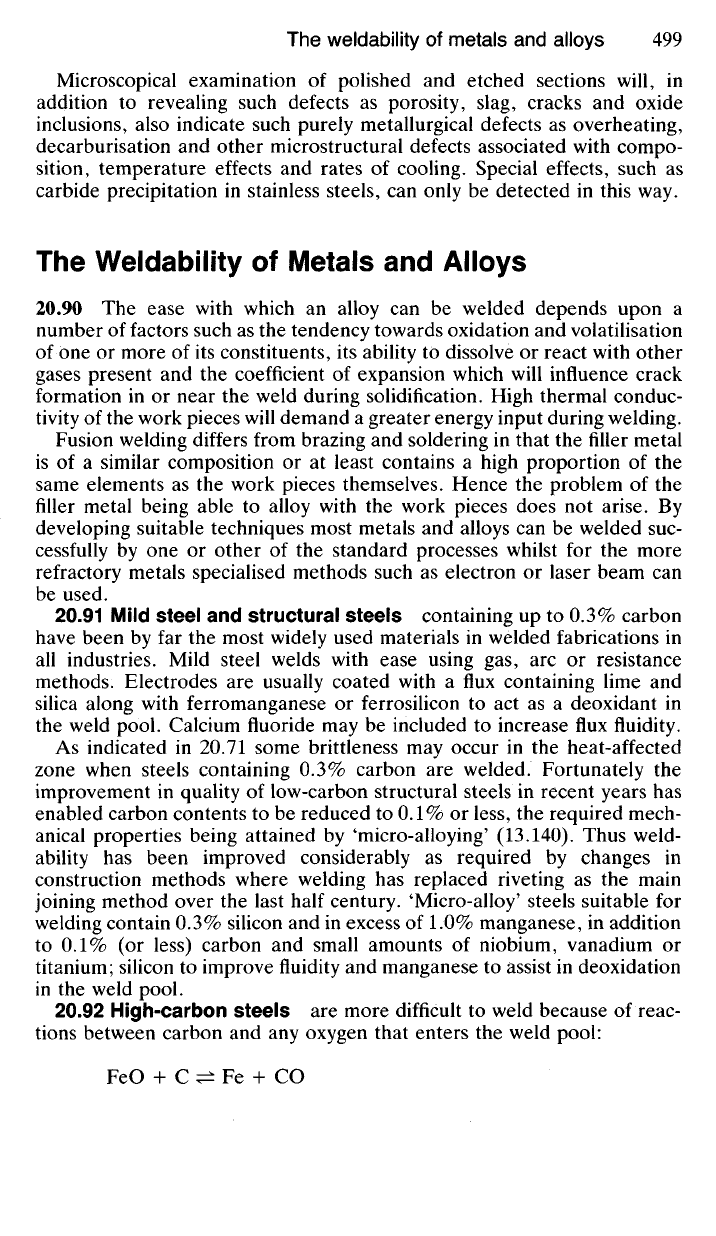
Microscopical examination of polished and etched sections will, in
addition to revealing such defects as porosity, slag, cracks and oxide
inclusions, also indicate such purely metallurgical defects as overheating,
decarburisation and other microstructural defects associated with compo-
sition, temperature effects and rates of cooling. Special effects, such as
carbide precipitation in stainless steels, can only be detected in this way.
The Weldability of Metals and Alloys
20.90 The ease with which an alloy can be welded depends upon a
number of factors such as the tendency towards oxidation and volatilisation
of one or more of its constituents, its ability to dissolve or react with other
gases present and the coefficient of expansion which will influence crack
formation in or near the weld during solidification. High thermal conduc-
tivity of the work pieces will demand a greater energy input during welding.
Fusion welding differs from brazing and soldering in that the filler metal
is of a similar composition or at least contains a high proportion of the
same elements as the work pieces themselves. Hence the problem of the
filler metal being able to alloy with the work pieces does not arise. By
developing suitable techniques most metals and alloys can be welded suc-
cessfully by one or other of the standard processes whilst for the more
refractory metals specialised methods such as electron or laser beam can
be used.
20.91 Mild steel and structural steels containing up to 0.3% carbon
have been by far the most widely used materials in welded fabrications in
all industries. Mild steel welds with ease using gas, arc or resistance
methods. Electrodes are usually coated with a flux containing lime and
silica along with ferromanganese or ferrosilicon to act as a deoxidant in
the weld pool. Calcium fluoride may be included to increase flux fluidity.
As indicated in 20.71 some brittleness may occur in the heat-affected
zone when steels containing 0.3% carbon are welded. Fortunately the
improvement in quality of low-carbon structural steels in recent years has
enabled carbon contents to be reduced to 0.1% or less, the required mech-
anical properties being attained by 'micro-alloying' (13.140). Thus weld-
ability has been improved considerably as required by changes in
construction methods where welding has replaced riveting as the main
joining method over the last half century. 'Micro-alloy' steels suitable for
welding contain 0.3% silicon and in excess of 1.0% manganese, in addition
to 0.1% (or less) carbon and small amounts of niobium, vanadium or
titanium; silicon to improve fluidity and manganese to assist in deoxidation
in the weld pool.
20.92 High-carbon steels are more difficult to weld because of reac-
tions between carbon and any oxygen that enters the weld pool:
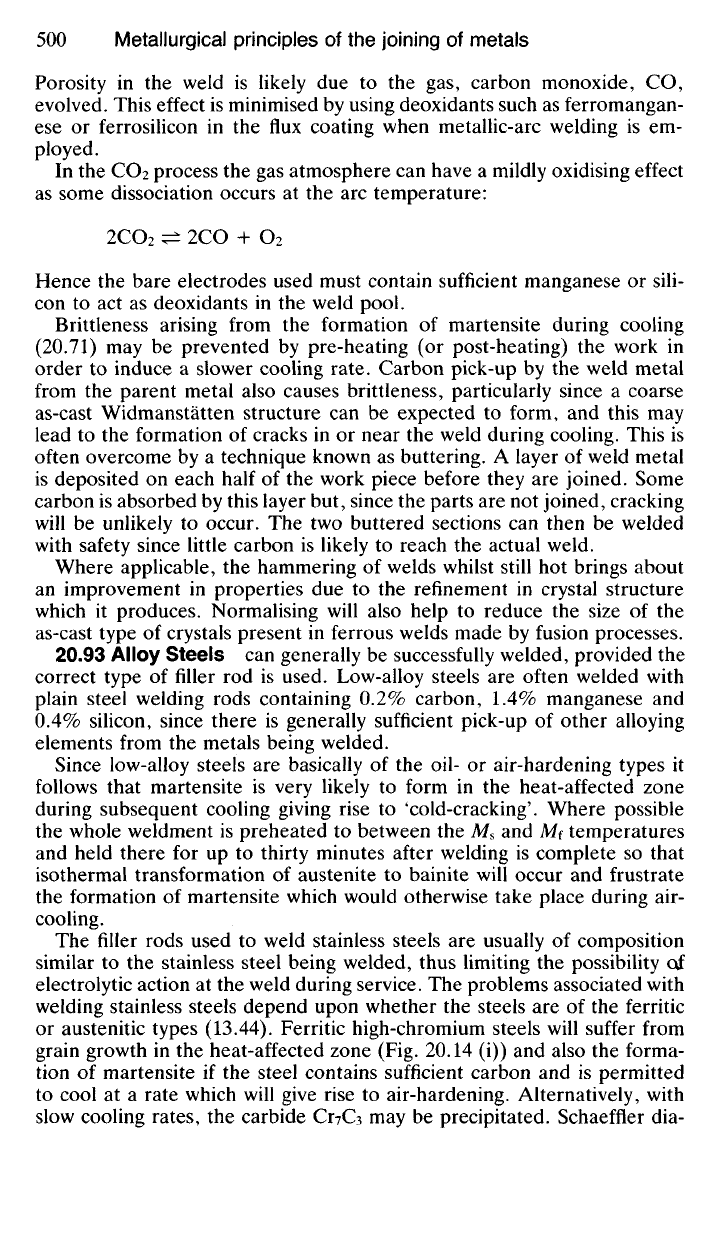
Porosity in the weld is likely due to the gas, carbon monoxide, CO,
evolved. This effect is minimised by using deoxidants such as ferromangan-
ese or ferrosilicon in the flux coating when metallic-arc welding is em-
ployed.
In the CO2 process the gas atmosphere can have a mildly oxidising effect
as some dissociation occurs at the arc temperature:
2CO
2
^ 2CO + O
2
Hence the bare electrodes used must contain sufficient manganese or sili-
con to act as deoxidants in the weld pool.
Brittleness arising from the formation of martensite during cooling
(20.71) may be prevented by pre-heating (or post-heating) the work in
order to induce a slower cooling rate. Carbon pick-up by the weld metal
from the parent metal also causes brittleness, particularly since a coarse
as-cast Widmanstatten structure can be expected to form, and this may
lead to the formation of cracks in or near the weld during cooling. This is
often overcome by a technique known as buttering. A layer of weld metal
is deposited on each half of the work piece before they are joined. Some
carbon is absorbed by this layer but, since the parts are not joined, cracking
will be unlikely to occur. The two buttered sections can then be welded
with safety since little carbon is likely to reach the actual weld.
Where applicable, the hammering of welds whilst still hot brings about
an improvement in properties due to the refinement in crystal structure
which it produces. Normalising will also help to reduce the size of the
as-cast type of crystals present in ferrous welds made by fusion processes.
20.93 Alloy Steels can generally be successfully welded, provided the
correct type of filler rod is used. Low-alloy steels are often welded with
plain steel welding rods containing 0.2% carbon, 1.4% manganese and
0.4% silicon, since there is generally sufficient pick-up of other alloying
elements from the metals being welded.
Since low-alloy steels are basically of the oil- or air-hardening types it
follows that martensite is very likely to form in the heat-affected zone
during subsequent cooling giving rise to 'cold-cracking'. Where possible
the whole weldment is preheated to between the M
s
and Mi temperatures
and held there for up to thirty minutes after welding is complete so that
isothermal transformation of austenite to bainite will occur and frustrate
the formation of martensite which would otherwise take place during air-
cooling.
The filler rods used to weld stainless steels are usually of composition
similar to the stainless steel being welded, thus limiting the possibility of
electrolytic action at the weld during service. The problems associated with
welding stainless steels depend upon whether the steels are of the ferritic
or austenitic types (13.44). Ferritic high-chromium steels will suffer from
grain growth in the heat-affected zone (Fig. 20.14 (i)) and also the forma-
tion of martensite if the steel contains sufficient carbon and is permitted
to cool at a rate which will give rise to air-hardening. Alternatively, with
slow cooling rates, the carbide Cr?C3 may be precipitated. Schaeffler dia-
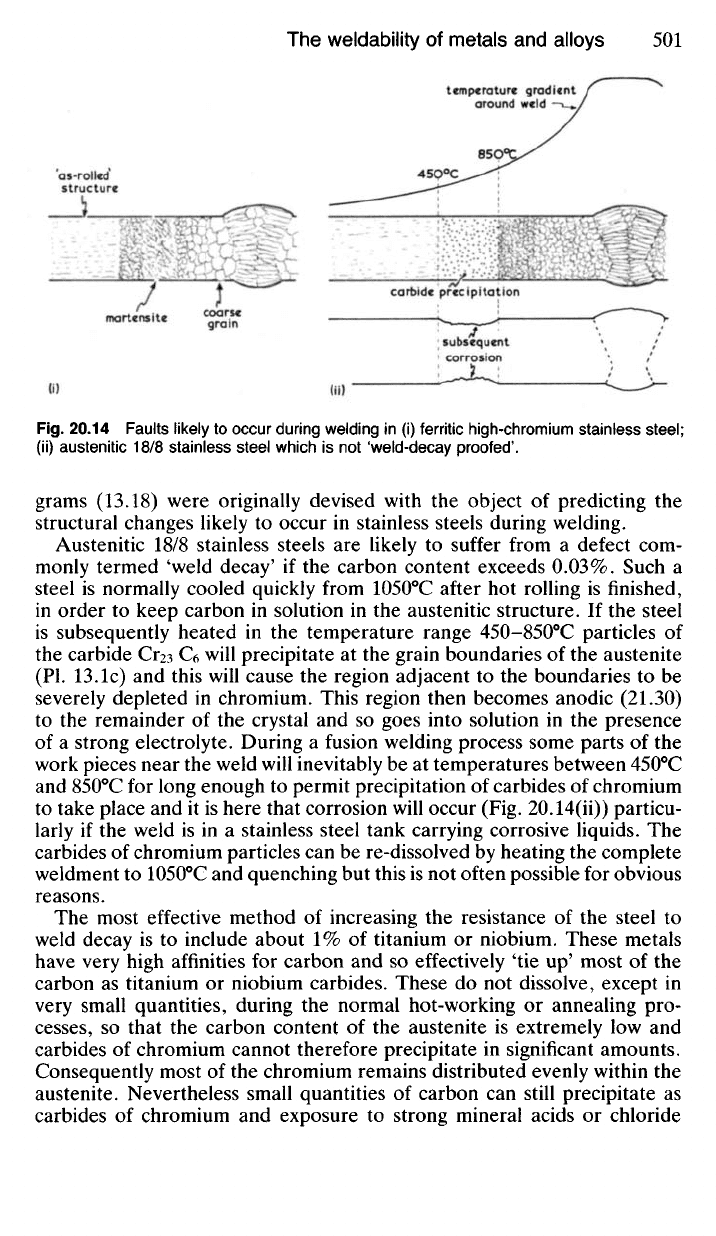
Fig.
20.14 Faults likely to occur during welding in (i) ferritic high-chromium stainless steel;
(ii) austenitic 18/8 stainless steel which is not 'weld-decay proofed'.
grams (13.18) were originally devised with the object of predicting the
structural changes likely to occur in stainless steels during welding.
Austenitic 18/8 stainless steels are likely to suffer from a defect com-
monly termed 'weld decay' if the carbon content exceeds 0.03%. Such a
steel is normally cooled quickly from 1050
0
C after hot rolling is finished,
in order to keep carbon in solution in the austenitic structure. If the steel
is subsequently heated in the temperature range 450-850
0
C particles of
the carbide Cr
2
3 C6 will precipitate at the grain boundaries of the austenite
(Pl.
13.1c) and this will cause the region adjacent to the boundaries to be
severely depleted in chromium. This region then becomes anodic (21.30)
to the remainder of the crystal and so goes into solution in the presence
of a strong electrolyte. During a fusion welding process some parts of the
work pieces near the weld will inevitably be at temperatures between 450
0
C
and 850
0
C for long enough to permit precipitation of carbides of chromium
to take place and it is here that corrosion will occur (Fig. 20.14(ii)) particu-
larly if the weld is in a stainless steel tank carrying corrosive liquids. The
carbides of chromium particles can be re-dissolved by heating the complete
weldment to 1050
0
C and quenching but this is not often possible for obvious
reasons.
The most effective method of increasing the resistance of the steel to
weld decay is to include about 1% of titanium or niobium. These metals
have very high affinities for carbon and so effectively 'tie up' most of the
carbon as titanium or niobium carbides. These do not dissolve, except in
very small quantities, during the normal hot-working or annealing pro-
cesses, so that the carbon content of the austenite is extremely low and
carbides of chromium cannot therefore precipitate in significant amounts.
Consequently most of the chromium remains distributed evenly within the
austenite. Nevertheless small quantities of carbon can still precipitate as
carbides of chromium and exposure to strong mineral acids or chloride
'as-rolled
structure
temperature gradient
around weld
carbide precipitation
martensite
coarse
grain
subsequent
corrosion
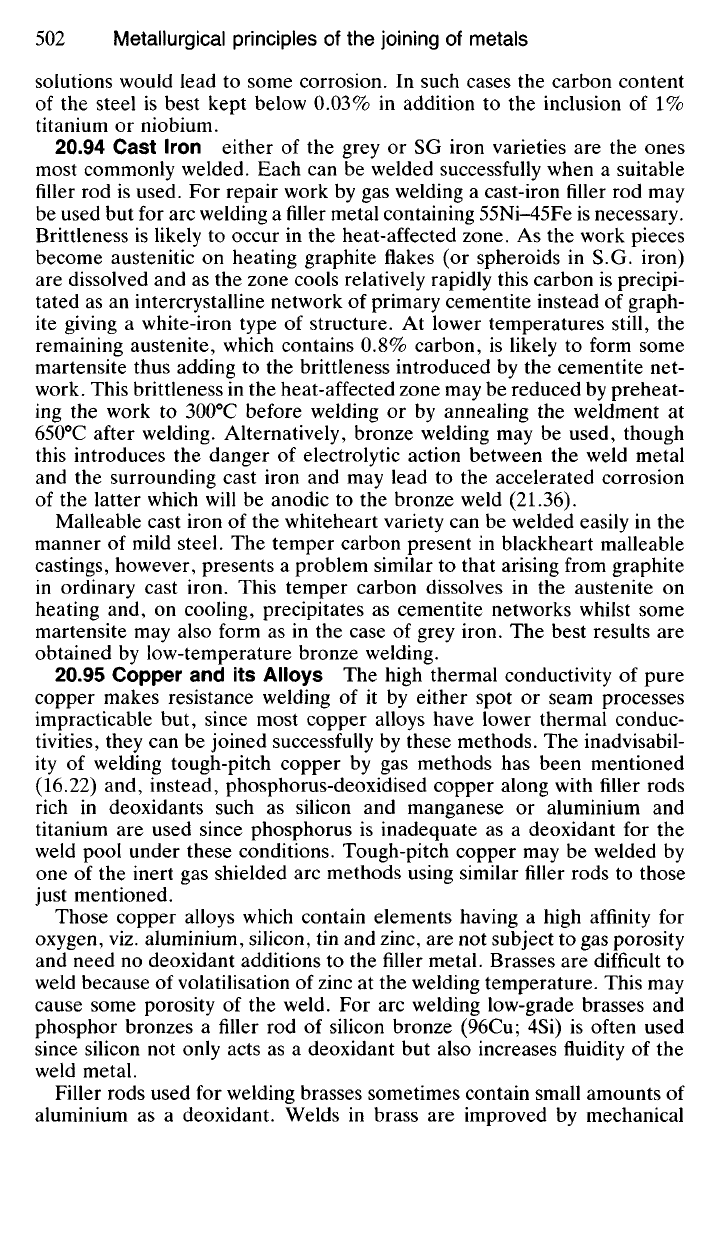
solutions would lead to some corrosion. In such cases the carbon content
of the steel is best kept below 0.03% in addition to the inclusion of 1%
titanium or niobium.
20.94 Cast Iron either of the grey or SG iron varieties are the ones
most commonly welded. Each can be welded successfully when a suitable
filler rod is used. For repair work by gas welding a cast-iron filler rod may
be used but for arc welding a filler metal containing 55Ni-45Fe is necessary.
Brittleness is likely to occur in the heat-affected zone. As the work pieces
become austenitic on heating graphite flakes (or spheroids in S.G. iron)
are dissolved and as the zone cools relatively rapidly this carbon is precipi-
tated as an intercrystalline network of primary cementite instead of graph-
ite giving a white-iron type of structure. At lower temperatures still, the
remaining austenite, which contains 0.8% carbon, is likely to form some
martensite thus adding to the brittleness introduced by the cementite net-
work. This brittleness in the heat-affected zone may be reduced by preheat-
ing the work to 300
0
C before welding or by annealing the weldment at
650
0
C after welding. Alternatively, bronze welding may be used, though
this introduces the danger of electrolytic action between the weld metal
and the surrounding cast iron and may lead to the accelerated corrosion
of the latter which will be anodic to the bronze weld (21.36).
Malleable cast iron of the whiteheart variety can be welded easily in the
manner of mild steel. The temper carbon present in blackheart malleable
castings, however, presents a problem similar to that arising from graphite
in ordinary cast iron. This temper carbon dissolves in the austenite on
heating and, on cooling, precipitates as cementite networks whilst some
martensite may also form as in the case of grey iron. The best results are
obtained by low-temperature bronze welding.
20.95 Copper and its Alloys The high thermal conductivity of pure
copper makes resistance welding of it by either spot or seam processes
impracticable but, since most copper alloys have lower thermal conduc-
tivities, they can be joined successfully by these methods. The inadvisabil-
ity of welding tough-pitch copper by gas methods has been mentioned
(16.22) and, instead, phosphorus-deoxidised copper along with filler rods
rich in deoxidants such as silicon and manganese or aluminium and
titanium are used since phosphorus is inadequate as a deoxidant for the
weld pool under these conditions. Tough-pitch copper may be welded by
one of the inert gas shielded arc methods using similar filler rods to those
just mentioned.
Those copper alloys which contain elements having a high affinity for
oxygen, viz. aluminium, silicon, tin and zinc, are not subject to gas porosity
and need no deoxidant additions to the filler metal. Brasses are difficult to
weld because of volatilisation of zinc at the welding temperature. This may
cause some porosity of the weld. For arc welding low-grade brasses and
phosphor bronzes a filler rod of silicon bronze (96Cu; 4Si) is often used
since silicon not only acts as a deoxidant but also increases fluidity of the
weld metal.
Filler rods used for welding brasses sometimes contain small amounts of
aluminium as a deoxidant. Welds in brass are improved by mechanical
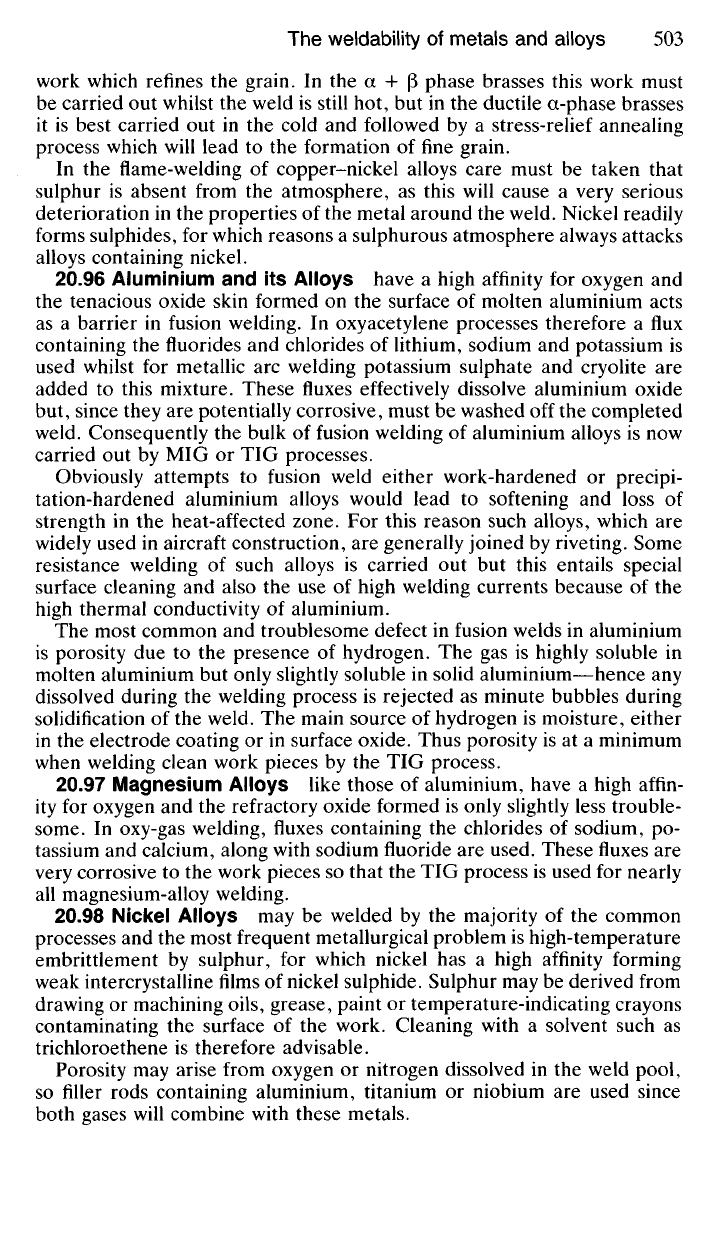
work which refines the grain. In the a + (3 phase brasses this work must
be carried out whilst the weld is still hot, but in the ductile a-phase brasses
it is best carried out in the cold and followed by a stress-relief annealing
process which will lead to the formation of fine grain.
In the flame-welding of copper-nickel alloys care must be taken that
sulphur is absent from the atmosphere, as this will cause a very serious
deterioration in the properties of the metal around the weld. Nickel readily
forms sulphides, for which reasons a sulphurous atmosphere always attacks
alloys containing nickel.
20.96 Aluminium and its Alloys have a high affinity for oxygen and
the tenacious oxide skin formed on the surface of molten aluminium acts
as a barrier in fusion welding. In oxyacetylene processes therefore a flux
containing the fluorides and chlorides of lithium, sodium and potassium is
used whilst for metallic arc welding potassium sulphate and cryolite are
added to this mixture. These fluxes effectively dissolve aluminium oxide
but, since they are potentially corrosive, must be washed off the completed
weld. Consequently the bulk of fusion welding of aluminium alloys is now
carried out by MIG or TIG processes.
Obviously attempts to fusion weld either work-hardened or precipi-
tation-hardened aluminium alloys would lead to softening and loss of
strength in the heat-affected zone. For this reason such alloys, which are
widely used in aircraft construction, are generally joined by riveting. Some
resistance welding of such alloys is carried out but this entails special
surface cleaning and also the use of high welding currents because of the
high thermal conductivity of aluminium.
The most common and troublesome defect in fusion welds in aluminium
is porosity due to the presence of hydrogen. The gas is highly soluble in
molten aluminium but only slightly soluble in solid aluminium—hence any
dissolved during the welding process is rejected as minute bubbles during
solidification of the weld. The main source of hydrogen is moisture, either
in the electrode coating or in surface oxide. Thus porosity is at a minimum
when welding clean work pieces by the TIG process.
20.97 Magnesium Alloys like those of aluminium, have a high affin-
ity for oxygen and the refractory oxide formed is only slightly less trouble-
some. In oxy-gas welding, fluxes containing the chlorides of sodium, po-
tassium and calcium, along with sodium fluoride are used. These fluxes are
very corrosive to the work pieces so that the TIG process is used for nearly
all magnesium-alloy welding.
20.98 Nickel Alloys may be welded by the majority of the common
processes and the most frequent metallurgical problem is high-temperature
embrittlement by sulphur, for which nickel has a high affinity forming
weak intercrystalline films of nickel sulphide. Sulphur may be derived from
drawing or machining oils, grease, paint or temperature-indicating crayons
contaminating the surface of the work. Cleaning with a solvent such as
trichloroethene is therefore advisable.
Porosity may arise from oxygen or nitrogen dissolved in the weld pool,
so filler rods containing aluminium, titanium or niobium are used since
both gases will combine with these metals.
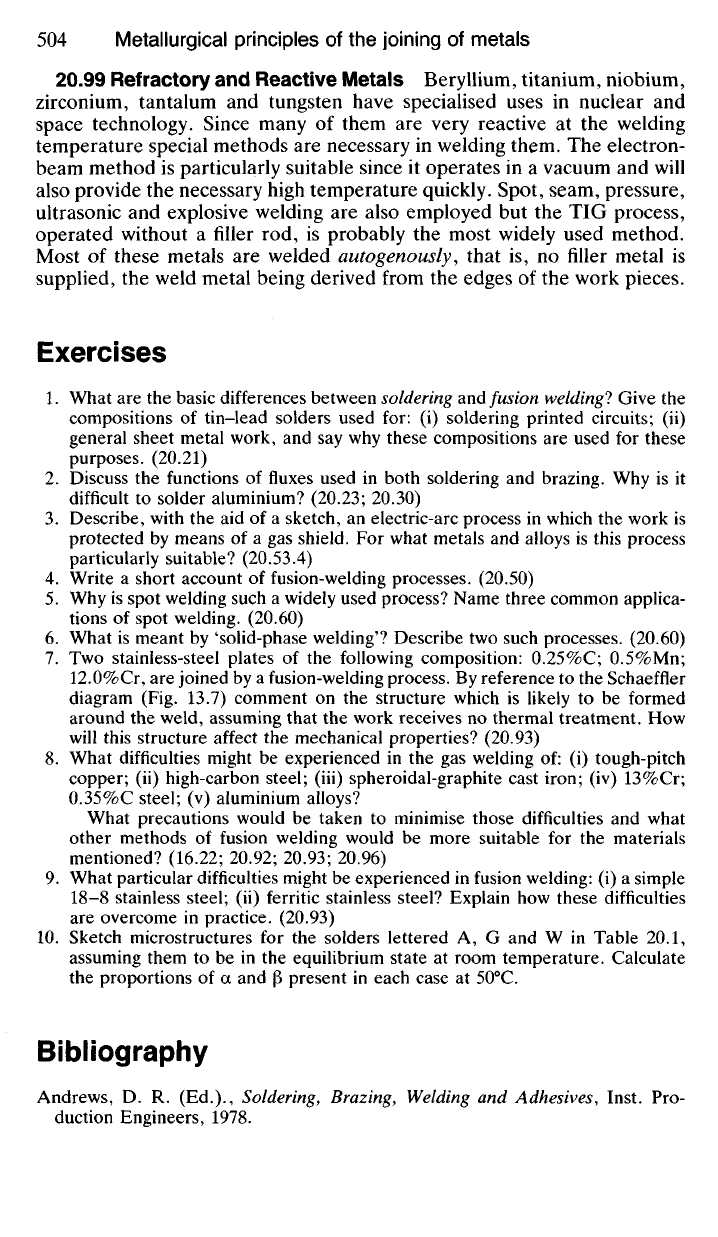
20.99 Refractory and Reactive Metals Beryllium, titanium, niobium,
zirconium, tantalum and tungsten have specialised uses in nuclear and
space technology. Since many of them are very reactive at the welding
temperature special methods are necessary in welding them. The electron-
beam method is particularly suitable since it operates in a vacuum and will
also provide the necessary high temperature quickly. Spot, seam, pressure,
ultrasonic and explosive welding are also employed but the TIG process,
operated without a filler rod, is probably the most widely used method.
Most of these metals are welded autogenously, that is, no filler metal is
supplied, the weld metal being derived from the edges of the work pieces.
Exercises
1.
What
are the
basic differences between soldering and fusion welding? Give
the
compositions
of
tin-lead solders used
for: (i)
soldering printed circuits;
(ii)
general sheet metal work,
and say why
these compositions
are
used
for
these
purposes. (20.21)
2.
Discuss
the
functions
of
fluxes used
in
both soldering
and
brazing.
Why is it
difficult
to
solder aluminium?
(20.23;
20.30)
3.
Describe, with
the aid of a
sketch,
an
electric-arc process
in
which
the
work
is
protected
by
means
of a gas
shield.
For
what metals
and
alloys
is
this process
particularly suitable? (20.53.4)
4.
Write
a
short account
of
fusion-welding processes. (20.50)
5.
Why is
spot welding such
a
widely used process? Name three common applica-
tions
of
spot welding. (20.60)
6. What
is
meant
by
'solid-phase welding'? Describe
two
such processes. (20.60)
7.
Two
stainless-steel plates
of the
following composition: 0.25%C; 0.5%Mn;
12.0%Cr,
are
joined
by a
fusion-welding process.
By
reference
to the
Schaeffler
diagram
(Fig. 13.7)
comment
on the
structure which
is
likely
to be
formed
around
the
weld, assuming that
the
work receives
no
thermal treatment.
How
will this structure affect
the
mechanical properties? (20.93)
8. What difficulties might
be
experienced
in the gas
welding
of: (i)
tough-pitch
copper;
(ii)
high-carbon steel;
(iii)
spheroidal-graphite cast iron;
(iv)
13%Cr;
0.35%C steel;
(v)
aluminium alloys?
What precautions would
be
taken
to
minimise those difficulties
and
what
other methods
of
fusion welding would
be
more suitable
for the
materials
mentioned? (16.22; 20.92;
20.93;
20.96)
9. What particular difficulties might
be
experienced
in
fusion welding:
(i) a
simple
18-8 stainless steel;
(ii)
ferritic stainless steel? Explain
how
these difficulties
are overcome
in
practice. (20.93)
10.
Sketch microstructures
for the
solders lettered
A, G and W in
Table
20.1,
assuming them
to be in the
equilibrium state
at
room temperature. Calculate
the proportions
of a and (3
present
in
each case
at
50
0
C.
Bibliography
Andrews,
D. R.
(Ed.)., Soldering, Brazing, Welding
and
Adhesives, Inst.
Pro-
duction Engineers,
1978.
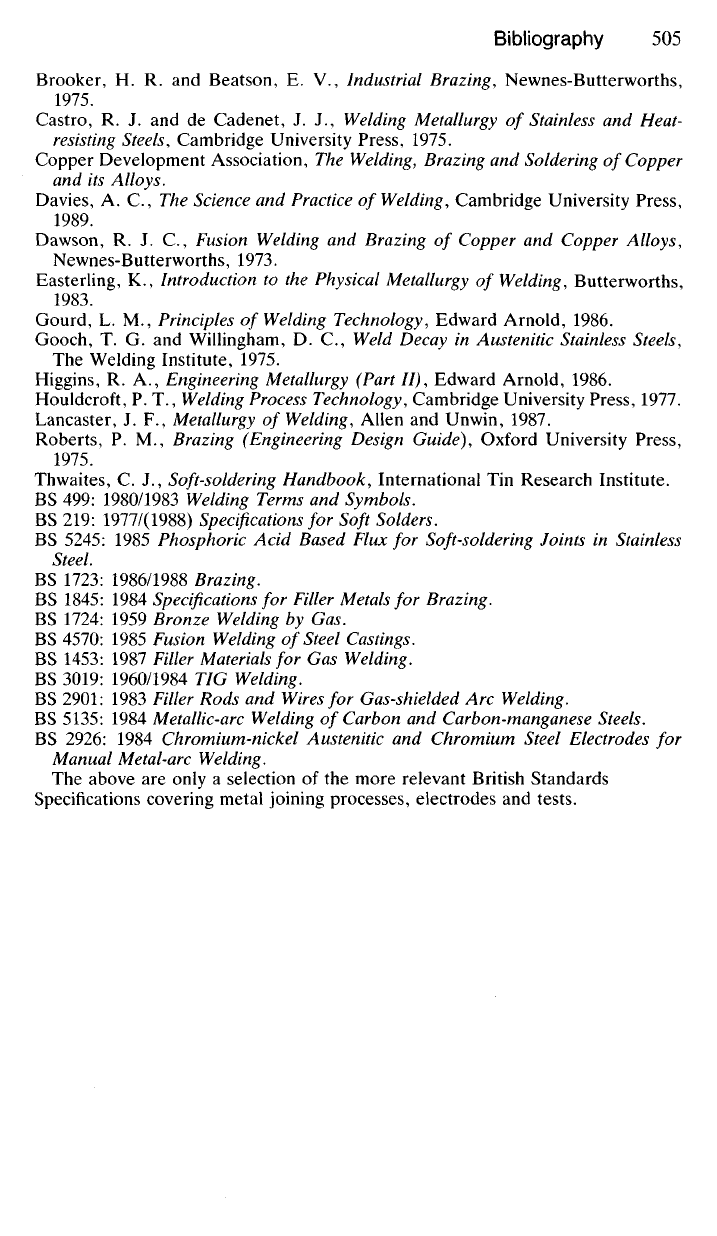
Brooker, H. R. and Beatson, E. V., Industrial Brazing, Newnes-Butterworths,
1975.
Castro, R. J. and de Cadenet, J. J., Welding Metallurgy of
Stainless
and Heat-
resisting
Steels, Cambridge University Press, 1975.
Copper Development Association, The Welding, Brazing and Soldering of Copper
and its Alloys.
Davies, A. C, The Science and
Practice
of Welding, Cambridge University Press,
1989.
Dawson, R. J. C, Fusion Welding and Brazing of Copper and Copper Alloys,
Newnes-Butterworths, 1973.
Easterling, K., Introduction to the Physical Metallurgy of Welding, Butterworths,
1983.
Gourd, L. M., Principles of Welding Technology, Edward Arnold, 1986.
Gooch, T. G. and Willingham, D. C, Weld Decay in Austenitic Stainless Steels,
The Welding Institute, 1975.
Higgins, R. A., Engineering Metallurgy (Part II), Edward Arnold, 1986.
Houldcroft, P. T., Welding
Process
Technology, Cambridge University Press, 1977.
Lancaster, J. F., Metallurgy of Welding, Allen and Unwin, 1987.
Roberts, P. M., Brazing (Engineering Design Guide), Oxford University Press,
1975.
Thwaites, C. J., Soft-soldering Handbook, International Tin Research Institute.
BS 499: 1980/1983 Welding Terms and Symbols.
BS 219: 1977/(1988)
Specifications
for Soft Solders.
BS 5245: 1985 Phosphoric Acid Based Flux for Soft-soldering Joints in Stainless
Steel.
BS 1723: 1986/1988 Brazing.
BS 1845: 1984
Specifications
for Filler
Metals
for Brazing.
BS 1724: 1959 Bronze Welding by Gas.
BS 4570: 1985 Fusion Welding of Steel Castings.
BS 1453: 1987 Filler
Materials
for Gas Welding.
BS 3019: 1960/1984 TIG Welding.
BS 2901: 1983 Filler Rods and
Wires
for
Gas-shielded
Arc Welding.
BS 5135: 1984
Metallic-arc
Welding of Carbon and
Carbon-manganese
Steels.
BS 2926: 1984 Chromium-nickel Austenitic and Chromium Steel Electrodes for
Manual
Metal-arc
Welding.
The above are only a selection of the more relevant British Standards
Specifications covering metal joining processes, electrodes and tests.
